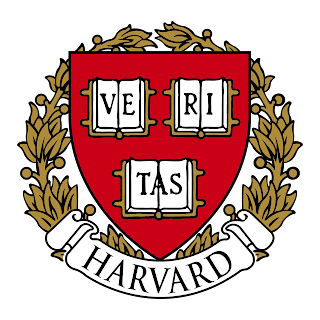A recent case of mass cheating, described as “unprecedented in anyone’s living memory,” made national news last August. It involved nearly half of 279 students in a class titled, ironically, “Introduction to Congress.” Which school? Guess. (Click here.)
Harvard’s truncated motto, Veritas, (Truth), rings hollow today. Did the founders of Harvard envision this?
 |
| This is the Harvard crest as it appears today. Compare it with the earlier Harvard crest I posted last week. (Scroll down if your memory is fuzzy.) Note that the lower book ("reason") is no longer facing downward, "submitted" to the God's special and general revelation, the Bible and creation. Notice, also, the wide, upward arrow pointing reason toward God's Word and works has been removed from the new crest. One has to wonder why they kept the book of God's Word and the book of God's works on the shield at all, but it's hard to remove them from stone, where they appear around the Harvard campus to this day. Most students, I'm sure, have no idea what the three books symbolize anyway. Notice, also, that the Latin words in the original motto, For Christ and the Church, have been eliminated. The revised Harvard motto has been reduced to simply Veritas (Truth). The photo above is from Wikipedia, and reprinted by fair use law. The Wikipedia article is worth reading, as it does a good job of relating the history of Harvard's secularization (click here). The article notes that "Charles W. Eliot, president 1869–1909 [40 years, no less!], eliminated the favored position of Christianity from the curriculum while opening it to student self-direction." Yes indeed. The recent cheating scandal attests to that. For more on the Harvard crest, see David Kirkpatrick's blog, Travels in Transmedia... (Thank you, Joan Nieman, for bringing Kirkpatrick to my attention.) |
Harvard’s truncated motto, Veritas, (Truth), rings hollow today. Did the founders of Harvard envision this?
What route did Harvard take from Pansophia to cheating-en-mass? How, and when, was the Bible dropped from its essential role as the provider of light for every academic subject, and the hub of academic integration? What happened to the Panshopic movement, and the three books on Harvard's crest?
A recent master's thesis by James A. Hopson includes a succinct history of Christian education in America that provides clues. Hopson relates how a reaction to the strictness of Puritan Calvinism led to a rise of liberal Unitarianism (which denied the deity of Christ). This, combined with a spiritual decline of the Congregational Church, a rise of "German pantheism," and Protestant infighting, led to a separation of the Bible from academics.
Harvard was taken over by Unitarians. Hopson quotes Blumenfeld: “The takeover of Harvard in 1805 by the Unitarians is probably the most important intellectual event in American educational history. Harvard became the ‘Unitarian Vatican.’ It was, in effect, the beginning of the long journey to the secular humanist world view that now dominates American culture.”
A recent master's thesis by James A. Hopson includes a succinct history of Christian education in America that provides clues. Hopson relates how a reaction to the strictness of Puritan Calvinism led to a rise of liberal Unitarianism (which denied the deity of Christ). This, combined with a spiritual decline of the Congregational Church, a rise of "German pantheism," and Protestant infighting, led to a separation of the Bible from academics.
Harvard was taken over by Unitarians. Hopson quotes Blumenfeld: “The takeover of Harvard in 1805 by the Unitarians is probably the most important intellectual event in American educational history. Harvard became the ‘Unitarian Vatican.’ It was, in effect, the beginning of the long journey to the secular humanist world view that now dominates American culture.”
In 1837, Horace Mann, also a Unitarian, became Secretary of Education for Massachusetts. Through Mann, the first public (tax-supported) schools were established. At that time, Protestants were warring over differences of doctrine taught in schools, and Mann's solution was to have schools just retain Bible reading for its moral benefit. Thus the road to dis-integration began.
But the transition to complete dis-integration took many years. McGuffey Readers, a “God-conscious and God-centered” series by a Presbyterian minister, continued to be used in public schools into the twentieth century. 120 million copies were sold between 1836 and 1920. The public schools were also seen by the Protestant community as a way of “neutralizing the influx of Catholic immigrants,” through the advancement of Protestantism.
But by the 1930s, a radically different vision for education emerged.But the transition to complete dis-integration took many years. McGuffey Readers, a “God-conscious and God-centered” series by a Presbyterian minister, continued to be used in public schools into the twentieth century. 120 million copies were sold between 1836 and 1920. The public schools were also seen by the Protestant community as a way of “neutralizing the influx of Catholic immigrants,” through the advancement of Protestantism.
I'll pick up from here next week.



